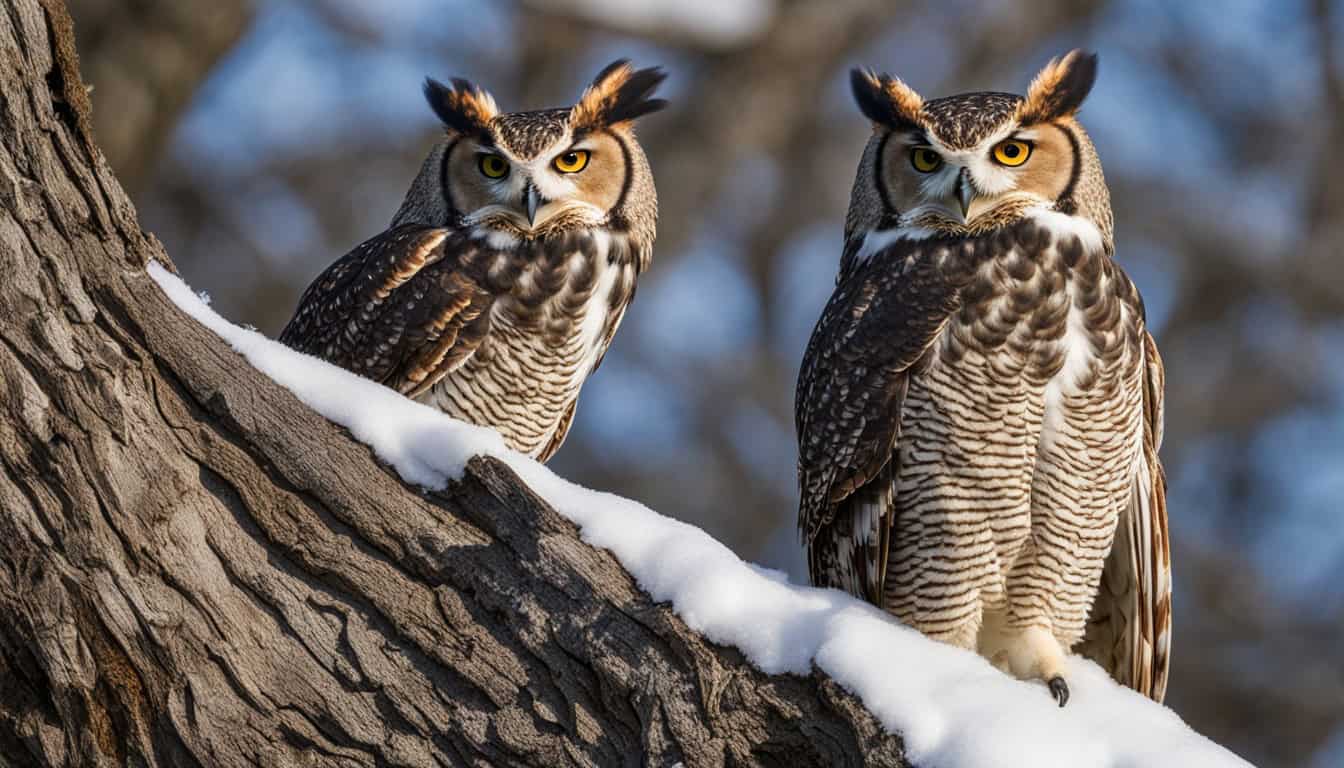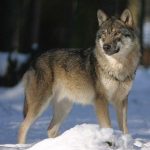Owl identification in the USA is hard because there are many types and they hide. The country has nineteen owl species, from the small Elf Owl to the big Great Gray Owl. Experts point out the differences in size, where they live, and how they act. This makes finding and figuring out owl types fun.
To know which owl is which, look at their ear tufts, size, and what color they are. Also, listen for their special sounds. For instance, the Barred Owl says, “Who cooks for you?” and the Barn Owl makes a scary scream. Hearing and seeing these clues can help you tell owl species apart and enjoy America’s owl diversity.
Common Owl Species in the USA
In the United States, you’ll find many owl species, each with its own unique traits and living spaces. Knowing about these traits helps in spotting and enjoying these amazing birds.
Barn Owl
The Barn Owl is known for its face shaped like a heart and its amazing hearing skills. To recognize a Barn Owl, listen for its loud, unusual calls. They are often found in open areas. Their power to find food just by hearing it makes them incredibly interesting to scientists studying owls.
Great Horned Owl
The Great Horned Owl has distinctive ear tufts and is very strong. It can live in many places, from forests to open fields. But, it prefers to be in thick trees or on high branches where it can easily see its prey. This owl is big and eats a variety of animals, sometimes even other hunters in the sky.
Barred Owl
The Barred Owl has a round head and a call that sounds like “Who cooks for you?” These calls are key to finding them. They love living in forests that are old and diverse. Because of this, their numbers have grown a lot. They are good at moving in their homes, even with other owls around.
If you study where owls live, listen to their calls, and learn about what they look like, you’ll improve your birdwatching trips.
Identifying Owls by Size
Owls come in many sizes across the USA. From the tiny Elf Owl to the big Great Gray Owl, there is a broad spectrum. Looking at an owl’s size closely can help us figure out which kind it is.
Large Owls
The Great Horned Owl and Snowy Owl are some of the biggest. Known for their wide wings and size, they stand out. You can find these big owls in various places. This makes them easy to remember.
Medium-Sized Owls
The Barred Owl and Boreal Owl fit into the medium category. What’s interesting is, the females are often bigger than males. This difference makes them easy to identify.
Small Owls
Then we have the small owls. The Elf Owl and Northern Pygmy-Owl are really tiny. They challenge us to spot their details accurately. Despite their size, they play a big role among owl types in the USA.
Distinguishing Features: Ear Tufts
In the world of owl species identification, ear tufts are key. They help us pick out different owls. This is super helpful when you’re out birdwatching or studying birds in the wild.
Owls with Ear Tufts
Some American owl species have clear ear tufts. If you see a Great Horned Owl or a Long-eared Owl, you’ll notice these right away. Their ear tufts make them easy to recognize, even at night when they’re most active.
Owls without Ear Tufts
But not all owls have ear tufts. The Barn Owl and the Barred Owl, for example, have smooth heads. This difference is important for telling owl species apart. It helps us group them with others like the Barn Owls in the Tyto group.
Knowing about ear tufts helps in many ways. It tells us about the owl’s group and what it does in its environment. This makes birdwatching more interesting and educational.
Plumage Color and Markings
An owl’s feathers are key for telling owl species apart. They help bird watchers see the different types of owls in America. The patterns on these feathers also let owls hide well in nature.
Spotted and Striped Patterns
Many owls have spotted or striped patterns. Take the Eastern Screech-Owl, for example. Its feathers look like tree bark, letting it hide easily. The Spotted Owl stands out with distinct spots, making it easier for birders to find.
Solid and Blended Colors
Some owls are just one color or a mix of colors. Look at the Great Gray Owl, blending with gray and brown. This helps it not get noticed in the forest. The Snowy Owl is known for its all-white feathers, perfect for hiding in the snow.

| Owl Species | Primary Plumage Pattern | Colors |
|---|---|---|
| Eastern Screech-Owl | Spotted & Striped | Gray, Brown |
| Spotted Owl | Spotted | Brown, Black |
| Great Gray Owl | Solid & Blended | Gray |
| Snowy Owl | Solid | White |
Knowing these feather patterns helps a lot in owl identification and study. From seeing the Spotted Owl’s unique spots to the Great Gray blending in, every sighting becomes more interesting.
Habitat Preferences of Different Owl Species
It’s key to know where various owls like to live to find them better. In the U.S., owls are found in many places, fitting their needs for hunting and breeding. This knowledge helps us place owls in different groups by their habits.
The Burrowing Owl lives on the ground in open grasslands. It uses burrows dug by small animals. This makes them easier to find. On the other hand, Boreal Owls love dense fir forests. They like cool, dark places to hide from prey and other animals.
Looking at more owl types shows even bigger differences in habitats:
| Owl Species | Preferred Habitat |
|---|---|
| Great Horned Owl | Variety of habitats including woodlands, wetlands, and urban areas |
| Snowy Owl | Arctic tundra and open fields during migration |
| Barred Owl | Mature mixed forests, often near water |
Knowing where owls like to be helps with spotting and understanding them. It shows how they adapt to different environments. This helps with grouping owls based on owl habitat identification. By understanding their home choices, people and scientists can guess where they are. This makes it easier to keep an eye on them for studying and protecting across America.
Vocalizations and Calls
Understanding owl vocalizations is key for finding and identifying owls. Owls make a variety of sounds that reveal their species, even if you can’t see them. For instance, the Barred Owl’s owl call is famous for its rhythmic tone, often asking,
“Who cooks for you?”
This makes it stand out in the wild. On the other hand, the Barn Owl’s call is sharp and eerie, making it well-known in the dark.
Knowing these owl vocalizations lets you tell owl types apart. Identifying if an owl hoots, screeches, barks, or whistles really helps. This is super important in thick woods or at night, where seeing owls is hard.
- Barred Owl: Rhythmic hooting, “Who cooks for you?”
- Barn Owl: High-pitched screeches
- Great Horned Owl: Deep, resonant hoots
- Eastern Screech-Owl: Whinnies and trills
- Snowy Owl: Harsh bark and hoot calls
| Owl Species | Types of Calls |
|---|---|
| Barred Owl | Rhythmic hooting, “Who cooks for you?” |
| Barn Owl | High-pitched screeches |
| Great Horned Owl | Deep, resonant hoots |
| Eastern Screech-Owl | Whinnies and trills |
| Snowy Owl | Harsh bark and hoot calls |
Behavior and Hunting Techniques
Owls have unique ways of hunting and behavior that show us a lot. They adapt their skills to where they live. Imagine the scene – forest owls that wait quietly before striking at their prey, or others that float over fields.
Let’s focus on a couple of owl types. Short-eared Owls fly low in open spaces, making it easy for them to get small creatures. Northern Pygmy-Owls, on the other hand, are super nimble. They can even catch prey bigger than they are.
To really get owl behavior, we should look at how they catch food. Each owl has its own special way. When we study this, we see how owls fit as the top hunters in their areas.
| Species | Behavior | Hunting Technique |
|---|---|---|
| Short-eared Owl | Deliberate low flights | Pouncing on small mammals in open areas |
| Northern Pygmy-Owl | Agile predation | Catching larger prey compared to its size |
| Great Horned Owl | Perching and pouncing | Silent swoop on prey from a perch |
| Barn Owl | Quartering flight | Hovering and swooping on rodents in open fields |
Conservation Status of Various Owl Species in the USA
The owls in the USA face both challenges and victories. Some species are doing well, but others are in trouble. For example, the Short-eared Owl and Snowy Owl numbers are dropping fast. This is mainly because they are losing their homes and facing other dangers.
Despite getting help from the law, the Northern Spotted Owl is still fighting. Its fight is against losing its home to other owls and to those cutting down forests. To save these owls, we need to protect their homes, keep them safe by law, and tell everyone how important they are.
It’s key to know what’s happening with these owls for us to help them. By keeping up to date and helping, we can make sure these incredible owls stay around.
FAQ
How do you distinguish between different types of owls in the USA?
Different owl species look different and have unique traits. Features like ear tufts, size, and color matter. So does how they sound and where they live. These all help to tell them apart.
What are some common owl species in the USA?
In the USA, you can find owls like the Barn Owl and Great Horned Owl. Each owl has its special traits. For example, the Barn Owl has a heart-shaped face. The Great Horned Owl has big ear tufts. And the Barred Owl has a unique call.
How can you identify a Barn Owl?
Barn Owls have a unique heart-shaped face and don’t have ear tufts. They mostly have white and golden-brown feathers. They live in open areas like fields and farms.
What are the distinctive features of the Great Horned Owl?
The Great Horned Owl is known for its big ear tufts. It also has a wide wingspan and gray-brown feathers. This owl makes a deep hooting sound and lives in various places like forests.
How can you identify a Barred Owl?
Barred Owls stand out with their round heads and unique call. They look for food in mature forests. Their feathers are brown and white, creating a streaked pattern.
What are the size categories of owls in the USA?
Owls in the USA come in different sizes: large, medium, and small. Large owls include the Great Gray Owl and Snowy Owl. Barred Owls and Boreal Owls fall in the medium category. And the Elf Owl and Northern Pygmy-Owl are among the small group.
Which owls have ear tufts?
Owls like the Great Horned Owl and Long-eared Owl have ear tufts. These tufts are key in recognizing them.
Which owls do not have ear tufts?
The Barn Owl and Barred Owl do not have ear tufts. Their round head shapes help to spot them.
What are the plumage color variations in owls?
Owl feathers can be many colors and patterns. For instance, there’s the Eastern Screech-Owl with spots. And the Spotted Owl. Then, the Great Gray Owl and Snowy Owl have more solid colorings.
How does habitat preference help in identifying owl species?
Each owl likes a different home, aiding in their ID. For example, the Burrowing Owl likes open spaces. The Boreal Owl prefers thick forests. Knowing these facts can reveal an owl’s type.
How do owl vocalizations assist in identification?
Each owl’s sound is special and helps ID them. The Barred Owl hoots a certain way. The Barn Owl makes different sounds. Knowing these calls is a big help.
What are some owl hunting behaviors used in identification?
Owls hunt in unique ways. The Short-eared Owl flies low over fields. The Northern Pygmy-Owl is quick on bigger prey. Spotting these actions can tell us which owl is which.
What is the conservation status of various owl species in the USA?
Owls in the USA face different conservation challenges. Some, like the Snowy Owl, need help due to habitat loss. The Northern Spotted Owl is protected but faces population issues. Conservation is vital for these owls’ futures.







